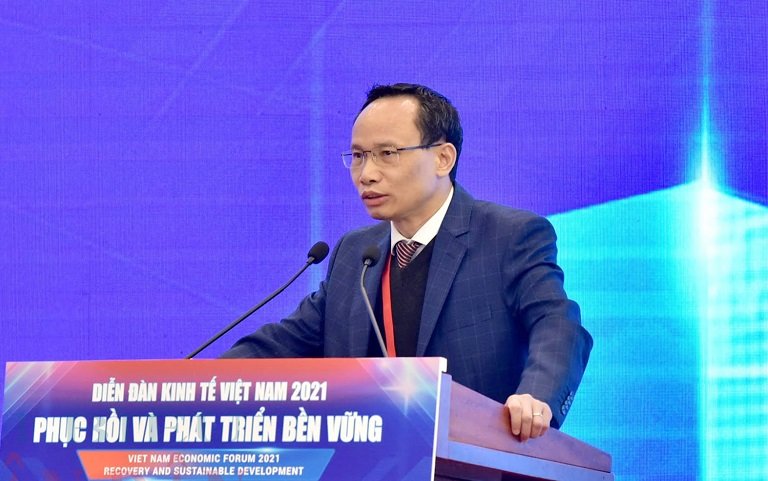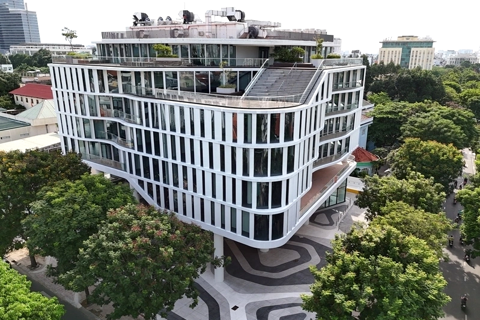Vietnam’s economic recovery program may go up to $30 billion: Experts
The GDP growth is set to expand by 4-4.5% in 2022, along with inflation rates of 3.4-3.7%, or a rise from an estimated 2% rate this year.
Vietnam’s upcoming economic recovery program maybe around 5.5-8% of the GDP, or VND445.76-666 trillion ($19.5-30 billion).
| NA Chairman Vuong Dinh Hue at the event. |
The figures were estimated by Economist Can Van Luc, representative of the research team of the Economic Committee under the National Assembly (NA) at the Vietnam Economic Forum 2021 held by the NA today [December 5], which serves as a platform to seek experts’ opinion regarding the socio-economic recovery program.
According to Luc, Vietnam’s economic recovery is U-shaped, instead of the V one, after the last four Covid-19 outbreaks.
“During these periods, the Government has flexibly maneuvered monetary and fiscal policies with rescue packages totaling nearly 4% of the GDP [including a fiscal package of 2.9% of the GDP and monetary support of 1.1%],” said Luc, but noting the size remains modest compared to regional countries.
In long term, Luc noted as the pandemic continues to stay unpredictable and in the face of limited vaccine supplies, the economic growth would be under pressure due to increasing living and production costs.
“The emergence of Omicron variant would have negative impacts on the global economy, and the Vietnamese economy is no exception,” he continued.
“The GDP growth is set to expand by 4-4.5% in 2022, along with inflation rates of 3.4-3.7%, or a rise from an estimated 2% rate this year,” Luc added.
“Without special support program or monetary and fiscal stimulus packages, Vietnam would face the risk of losing growth opportunities, and thus, would not realize its five-year economic targets,” Luc stressed.
Referring to international experiences in drafting an economic recovery program that is based on monetary and fiscal policies, Luc said in the case of Vietnam, the country still has significant room to exercise fiscal support.
He added the country’s fiscal deficit and public debt have been in better control against the previous period and are now within the safe threshold, which lay the foundation for expansionary fiscal policies during the 2022-2023 period.
Meanwhile, the size of fiscal support at nearly 3% of the GDP remains insufficient, he added.
| Economist Can Van Luc. |
In terms of monetary policy, the fact that the average interest rate has been at the lowest in the past 20 years and the low absorption capability of the economy means there's not much room left to further cut the lending rates.
“The high inflationary pressure in 2022 is also a source of concern,” Luc said, but adding there should be both direct and indirect measures for banks to further cut their lending rates by 0.5-1% per annum.
The combined value of fiscal, monetary supports, and other policies should be around VND445.76 trillion (19.5 billion), or 5.5% of the 2021 GDP.
“The economy is capable of absorbing such an amount in the coming time,” he added.
“A speedy and effective implementation of these programs that combine with other supports would ensure the recovery of the economy,” Luc said.
SOEs privatization, government bonds to finance support programs
Bui Quang Tuan, director of the Vietnam Academy of Social Sciences (VASS), stressed the necessity to have a sufficient support program to aid both the supply and demand sides of the economy.
“These programs should be in association with digitalization and green growth,” Tuan said.
Tuan added the recovery program in the 2022-2023 period should be around VND666 trillion ($30 billion), or 8% of the GDP of 2020, including a supporting program for the healthcare system of VND76 trillion ($3.32 billion); social welfare of VND58 trillion ($2.53 billion); business support of VND244 trillion ($10.7 billion), and public investment of VND288 trillion ($12.6 billion).
Experts at the event shared the view that the support should focus on workers and businesses, for which the said amounts should be fully disbursed within the next two years.
The fiscal deficit, on the other hand, may rise by one percentage point as a result during the period.
“Financial sources could come from saving costs, accelerating privatization, divestment of state capital, and issuance of government bonds,” said Tuan.
In this regard, Economist Luc said the Government may consider using a non-state budget or part of the foreign reserves if needed.
In his opening speech, NA Chairman Vuong Dinh Hue reiterated the goal to boost economic recovery but also take into consideration long-term targets for sustainable and rapid development.
“It is essential for Vietnam to maintain stable macro-economic foundations and put inflation under control,” Hue said.
Hue urged Government agencies to ensure transparent and effective implementation of upcoming support programs, not only the one financed by the state resources, but by the private sector as well.













